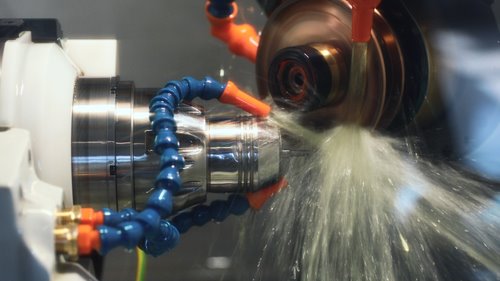E-Sharp News
November 2019
Jeremy Bunting, Managing Director of Facet Precision Tool grew up in the cutting tool industry, getting a hands-on education from a young age and then using this experience to start his own business. From laying out a brand-new manufacturing centre; to shaping and promoting Facet’s reputation; to training up a high performing team who are passionate about the craft of cutting tools – Jeremy has built the foundations for success.
Jeremy begins:
I started designing my first tools at age 14 in America as part of the family business, using manual grinding as well as conventional grinding to manufacture tools. After that I moved on to the applications side - getting exposure to feeds and speeds and eventually moved to Europe. In Europe I worked for different tooling manufacturers, seeing different approaches to manufacturing and precision tooling.
I started Facet Precision Tools in 2015 primarily to service the aerospace and automotive sectors. Both these markets require special tools with distinct needs. At Facet we produce PCD, carbide cutting and coated carbide tools through distributers and direct to customers. Based in Germany we sell locally as well as to France, England and Spain. Through distributers we service Africa, Sweden, Turkey, Hungary, Austria, Italy and Mexico.
It's challenging starting a new business. We had a market and products in mind and were in a unique position where we could decide, if these are our target markets, what machinery and equipment do we need? I considered my past experiences in the industry and how can I apply any learnings to the future. When we entered the market, I wanted to have high quality equipment, robust manufacturing processes and be producing market leading cutting tools.
Since opening we have been growing steadily, in fact last year we doubled our sales. As we expand we are looking at how we can attract more customers, consider if we need to add additional products and as many people in the industry experience – are always looking for good people.
Establishing grinding capabilities
After deciding on a shop floor blue print, we invested in a range of ANCA machines with two MX7 Linear’s, an FX7 and an EDGe as well as other equipment. We use the MX7s primarily for automotive tooling as they work well when grinding tools with larger diameters of 20, 25 and 32. We also run a lot of pocket grinding for PCD cutting tools on this model. The MX7 has a lot of horsepower that allows us to grind these tools in a very stable way. We use the FX for high volume carbide tooling. As an extremely rigid and thermally dynamic, stable machine I can rely on it to grind highly repeatable cutting tools.
On the MX7 we have an ANCA spindle speeder that allows us to achieve higher rpm. We worked with ANCA to adjust the software to be able to provide a better stable pocket and a more accurate pockets in our grinding process.
On the EDGe we manufacture PCD tools. In the past couple years we have been developing PCD vein tools with our own blanks and cutting tool designs – working through and refining our processes. The EDGe has allowed us to have a high degree of accuracy when trying to grind a lot of the geometries. I found that as a process, erosion enabled the repeatability and the quality we were looking for. We also added a vision camera system on the EDGe, allowing for a quick inspection inside the machine, to get higher repeatability and better quality versus taking it out of the machine, and putting it back in.

And then there is ANCA’s 3D Cimulator program. Up to 95% of the designs and problem solving are done on the simulator; testing the grinding process, reviewing and modifying before you go into a machine. It is our strongest tool to increase efficiency and reduce waste and that is a major help to our profitability. For example, carbide is extremely expensive where you can be paying from 400 euros for a 32mm standard rod.
The simulator also shows estimated grinding times which has been a great tool for us to reduce cycle times. Last time it took us, for example, 20 minutes to make this tool, but after considering a new idea or different approach we can reduce that time to 18, 17 or even 15 minutes all through experimenting in a simulated grinding environment.
We have touch probes on all the machines that allow us to easily change wheel packs, qualify the wheel and start moving quickly. It also allows us to remove human error and ensures a higher finished quality. To be able to dress and probe the wheel, picking back up where you left off without having to change the set up is very advantageous.
One of the main reasons we love the ANCA machines is because of the software. We have found it to be extremely flexible and at Facet we don't use a lot of the standard ANCA programs and designs and instead do a lot of our work in profile editor, changing angles and profiles to meet the tool designs that we need. My Dad always said that ANCA was a software company that built a machine.
21 November 2019